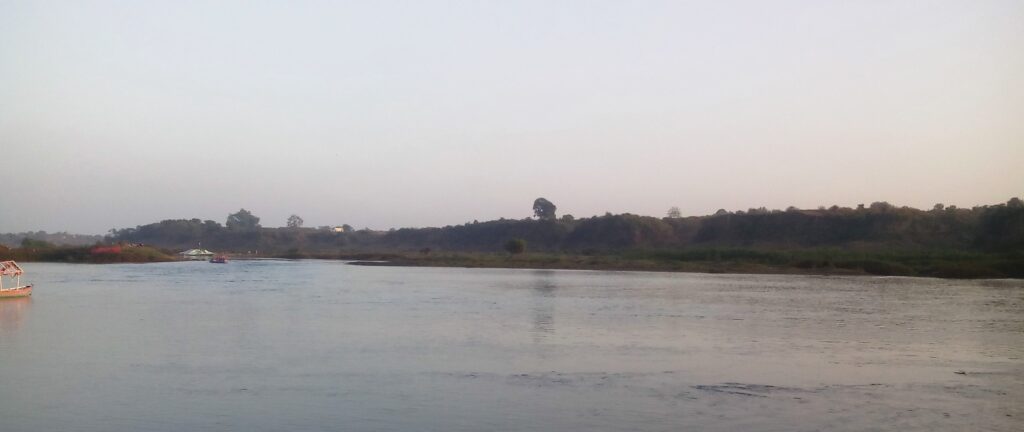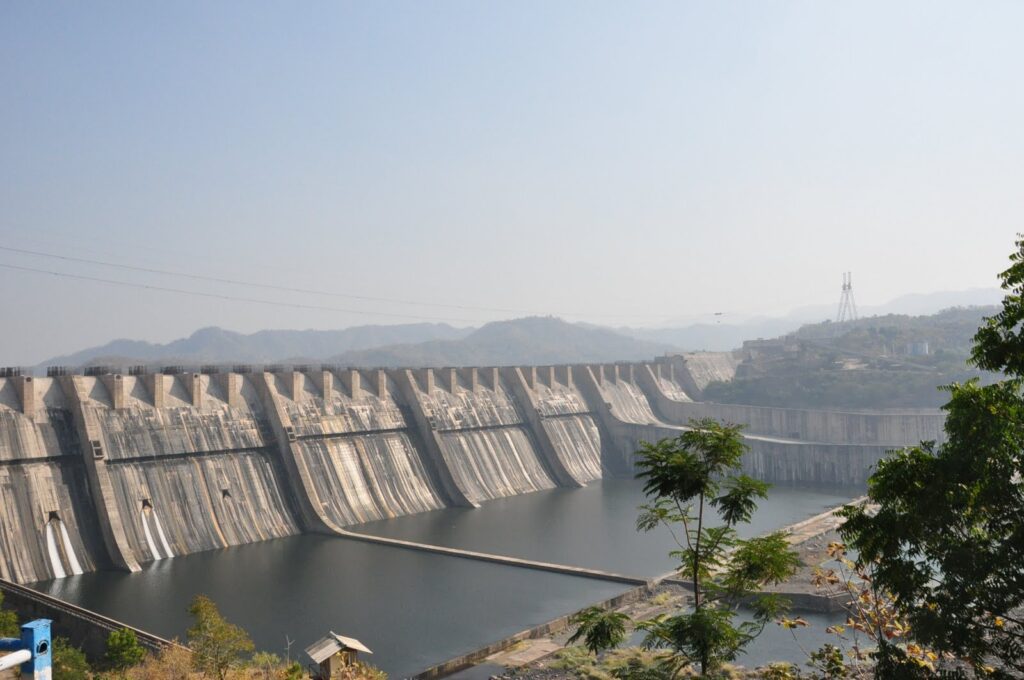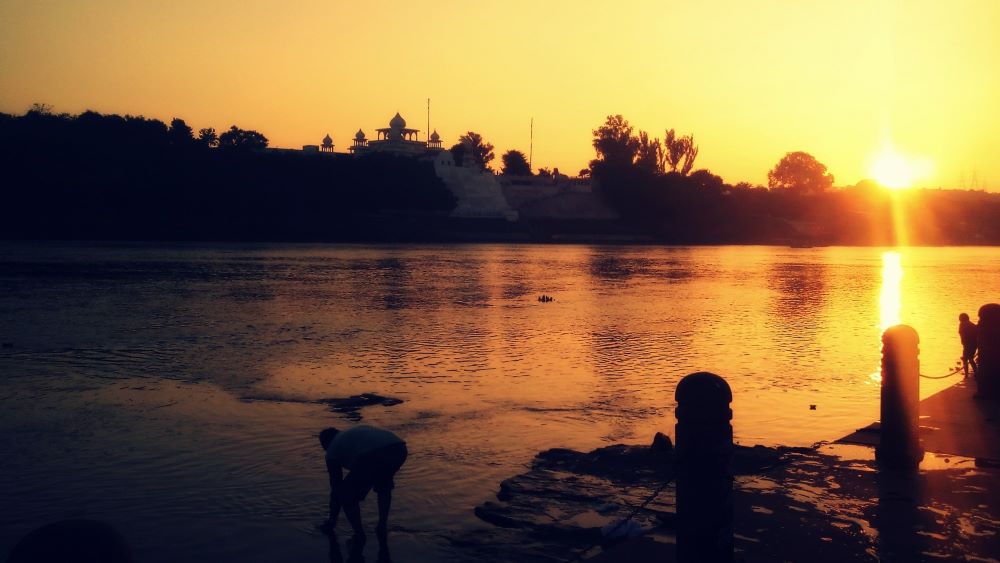From east to west, the Narmada River, one of Hinduism’s seven sacred rivers, runs through the middle of India. It is one of India’s largest west-flowing rivers and has significant cultural, religious, and environmental significance. For centuries, the Narmada River has been a source of water and energy for the surrounding areas. However, its construction and use have also sparked controversy. In this blog, we’ll talk about the Narmada River’s geography and history, its religious and cultural significance, the debates over its development, and the conservation efforts being made to keep this important river system in good condition. Come along with us as we learn about the fascinating world of the Narmada River and how crucial it is to protect its fragile ecosystem for future generations.
Geography of Narmada River
The Narmada River runs through the middle of India from east to west and is approximately 1,312 kilometers long. It flows through the states of Madhya Pradesh, Maharashtra, and Gujarat before reaching the Arabian Sea. It begins at the Amarkantak Plateau in the state of Madhya Pradesh. The Narmada River Basin spans parts of Madhya Pradesh, Gujarat, and Maharashtra and is approximately 98,796 square kilometers in size. The Banjar, Tawa, Sher, and Shakkar rivers serve as major tributaries to the Narmada River.

The Narmada Valley is a deep, narrow valley formed by the Narmada River that is home to a wide range of plant and animal species. The valley is important for agriculture, forestry, and wildlife conservation because it is surrounded by steep hills. In addition, the Narmada River and its tributaries are an important source of water for irrigation, drinking, industrial use, and hydroelectric power generation. As one of India’s few west-flowing rivers, the river’s flow is largely unregulated due to the absence of significant dams upstream to regulate it. The millions of people who live on the banks and in the surrounding areas of the Narmada River continue to rely heavily on it for both water and energy in spite of the challenges it faces.
Significance of Narmada River
Religious and Cultural Importance
In India, the Narmada River has a significant religious and cultural significance. The Narmada is revered as a symbol of purity and holiness in Hinduism because it is one of the seven sacred rivers. It is believed that taking a holy dip in the waters of the Narmada River, which attracts pilgrims from all over India, will cleanse the soul and forgive one sin.
The Hindu god Lord Shiva is also closely associated with the Narmada River. It is believed that Lord Shiva lives at the river’s source in the form of a lingam, an iconic representation of the god. As a result, the Amarkantak Plateau, the Narmada River’s source, has become a significant Hindu pilgrimage site.

The Narmada River has been a significant source of water and life for the people who have lived along its banks for thousands of years, so in addition to its religious significance, it also holds a significant cultural significance. The river and its tributaries have been a source of drinking water and irrigation water, supporting agriculture, forestry, and other livelihoods. Numerous ancient temples, monuments, and archaeological sites can be found along the banks of the Narmada River, which is also home to a rich cultural heritage in its valley.
Overall, the Narmada River is deeply ingrained in India’s religious and cultural heritage and holds a special place in the hearts of millions of people.
Irrigation and Hydroelectric Power Generation
In the central and western regions of India, the Narmada River and its tributaries are an important source of water for irrigation, drinking, and industrial purposes. The Narmada River supplies irrigation water to thousands of farms and villages in the region, which is rich in agriculture. The surrounding areas also rely heavily on the river for drinking water.

The Narmada River is utilized for both irrigation and drinking water, and it is also an important hydroelectric power source. Hydroelectric power generation is made possible by the river’s flow and the valley’s steep gradient. To take advantage of the Narmada River’s hydroelectric potential, a number of significant dams, including the Sardar Sarovar Dam and the Maheshwar Dam, have been constructed along its course. In addition to producing a significant amount of power, these dams supply irrigation and drinking water to the surrounding areas.
However, there has also been controversy surrounding the establishment of hydroelectric power on the Narmada River. Large dams, according to critics, can have significant negative effects on the environment, such as altering the natural flow of the river, displacing local communities, and destroying wildlife habitat. Additionally, they argue that local communities frequently bear the brunt of the negative effects of dam development and that the benefits of hydroelectric power are not evenly distributed. The Narmada River continues to be an important source of energy and water for India’s central and western regions despite these controversies.
Ecological Significance
A wide range of plant and animal species thrive in the ecologically significant Narmada River and its valley. A singular and diverse ecosystem, including tropical dry deciduous forests, grasslands, and wetlands, can be found in the Narmada Valley, which is surrounded by steep hills. Additionally, the valley is an important habitat for a number of endangered and threatened plant and animal species, including tigers, leopards, and a number of primates.
The central and western regions of India rely heavily on the Narmada River and its tributaries for irrigation, drinking, and industrial purposes. The river and its valley provide water for irrigation and drinking in addition to supporting thousands of farms and villages.

However, the environment and wildlife have also been significantly impacted by the Narmada River’s hydroelectric power development. The habitat and migration of fish and other aquatic species may be affected by large dams’ effects on the river’s flow and water quality. Dam construction can also result in the eviction of nearby communities and the destruction of wildlife habitat.
In conclusion, a distinctive and diverse ecosystem is supported by the Narmada River and its valley, a significant ecologically diverse region. The river continues to be a significant source of water and life for the millions of people who live along its banks and in the surrounding areas, despite the difficulties posed by development.
Controversies surrounding Narmada River
In India, the development of the Narmada River and its tributaries, including the construction of dams for the generation of hydroelectric power, has long been a source of contention and controversy. The following are some of the most significant disputes regarding the Narmada River:
Local communities’ displacement: Thousands of local communities, many of which have lived along the Narmada River for generations, have been forced to relocate as a result of the construction of large dams on the river. Critics contend that these communities have been forcibly relocated without adequate support or compensation, and that dam construction has cut them off from their homes, lands, and means of subsistence.
Effects on the environment: The construction of large dams, according to critics, can have significant negative effects on the environment, such as alterations in the flow of the river and its water quality, the destruction of wildlife habitat, and harm to the ecosystems that surround it.
Distribution of benefits: Local communities frequently bear the brunt of the negative effects of dam development, while large corporations and urban areas reap the benefits, according to critics, who argue that the benefits of hydroelectric power generated by the Narmada River are not evenly distributed.
Efficiency and expense: Additionally, critics contend that the efficiency of large dam projects is frequently exaggerated and that the associated costs are frequently exaggerated. They argue that alternative energy sources like solar or wind power should be investigated instead because the benefits of large dam projects frequently outweigh the costs.
Environmental groups, local communities, and human rights organizations have engaged in protests, legal challenges, and activism both domestically and internationally as a result of these controversies. The Narmada River continues to be an important source of energy and water for the western and central parts of India in spite of these obstacles.
Conservation Efforts for Narmada River
The need to preserve and safeguard the Narmada River and the ecosystems that surround it has gained more and more traction in recent years. The following are efforts to preserve the Narmada River and its valley:
Restoring the environment: efforts to restore degraded ecosystems and habitats along the Narmada River, which include protecting wetlands and grasslands and planting native trees and vegetation.
Conservation based on the community: programs that reduce pressure on the river and its ecosystems by involving local communities in conservation efforts and the creation of alternative means of subsistence, like ecotourism and sustainable agriculture.
Conservation and management of water: the development of alternate water sources for irrigation and drinking water, as well as efforts to improve water management and reduce waste, such as the promotion of effective irrigation practices and the implementation of water conservation measures.
Deconstruction and removal of the dam: restoration of river flow and water quality as part of efforts to decommission and remove old or obsolete dams, including the removal of structures that are no longer in use.
Investigation and monitoring: ongoing research and monitoring to learn more about how human activities affect the Narmada River and the ecosystems that surround it, as well as to find effective conservation and protection strategies.
These conservation efforts are crucial for the long-term health and well-being of the millions of people whose livelihoods and water needs are dependent on the Narmada River and its unique and diverse ecosystems.
Conclusion
The Narmada River is a significant and iconic Indian river that has significant ecological, economic, and social significance in addition to a long and illustrious cultural and religious history. However, the river’s development, which has included the construction of large dams for the generation of hydroelectric power, has been a source of controversy and conflict, with effects on the environment and local communities. Despite these obstacles, there is a growing awareness of the importance of conserving and protecting the Narmada River and the ecosystems that surround it. This includes restoring habitats that have been damaged, involving local communities in conservation efforts, improving water management and reducing waste, getting rid of old or useless dams, and keeping an eye on and researching the effects that human activity has had on the river. The long-term health and well-being of the millions of people whose livelihoods and water needs depend on the Narmada River is dependent on its conservation, as are the unique and diverse ecosystems of the Narmada Valley.
References and Further Reading
For more information about the Narmada River, you might look to the following sources:
“Narmada: A Valley Rises” by Arundhati Roy: This book provides a critical analysis of the development of the Narmada River and the displacement of local communities.
“The Narmada Valley Development Project: S. Jaiswal’s “A Study in Displacement, Resettlement, and Rehabilitation” is a comprehensive examination of the Narmada Valley development project, including its effects on the environment and local communities.
“Narmada: The Battle for the Valley” An anthology of essays and articles examining the cultural, social, and ecological facets of the Narmada River’s development is edited by Felix Padel and Samarendra Das.
“The Narmada Valley, India: An Archaeological Perspective” edited by R.S. Bisht and M.N. Deshpande, is a study of the Narmada Valley’s cultural, social, and environmental history from an archaeological perspective.
“The Narmada River Basin: Water, Livelihoods, and Governance, edited by Madhav Gadgil and Ramachandra Guha, is a collection of essays that look at how the Narmada River Basin is run, how it uses water, and how people make a living.
These citations and additional readings offer a variety of viewpoints and details about the Narmada River, its development, and its effects on the environment and local communities. They would be useful resources for anyone interested in learning more about this significant and complicated issue.
FAQs
Where does the Narmada River originate from?
The Maikal Range in Madhya Pradesh, India, is where the Narmada River gets its start.
What is the length of the Narmada River?
The length of the Narmada River is about 1,312 kilometers.
What is the Narmada River’s significance?
The Narmada River is significant for its cultural, religious, and ecological significance in addition to its significance for irrigation and the generation of hydroelectric power.
What are the controversies surrounding the Narmada River development?
Due to its impact on local communities and the environment, including the displacement of local populations and the loss of agricultural land, the Narmada River’s development, including the construction of large dams, has been controversial.
What conservation efforts are being made for the Narmada River?
Ecological restoration, community-based conservation, water management and conservation, dam removal and decommissioning, monitoring, and research are all components of the Narmada River conservation efforts.
What significance does the Narmada River have in terms of religion and culture?
In many Indian communities, the Narmada River is regarded as sacred and has a long and illustrious cultural and religious history. Hindu devotees also make it a major pilgrimage site.
What significance does the Narmada River have for the environment?
Numerous threatened and endangered species of wildlife and plants can be found in the ecosystems surrounding the Narmada River. For the sake of ecological health and the preservation of biodiversity, it is essential to preserve these ecosystems.







